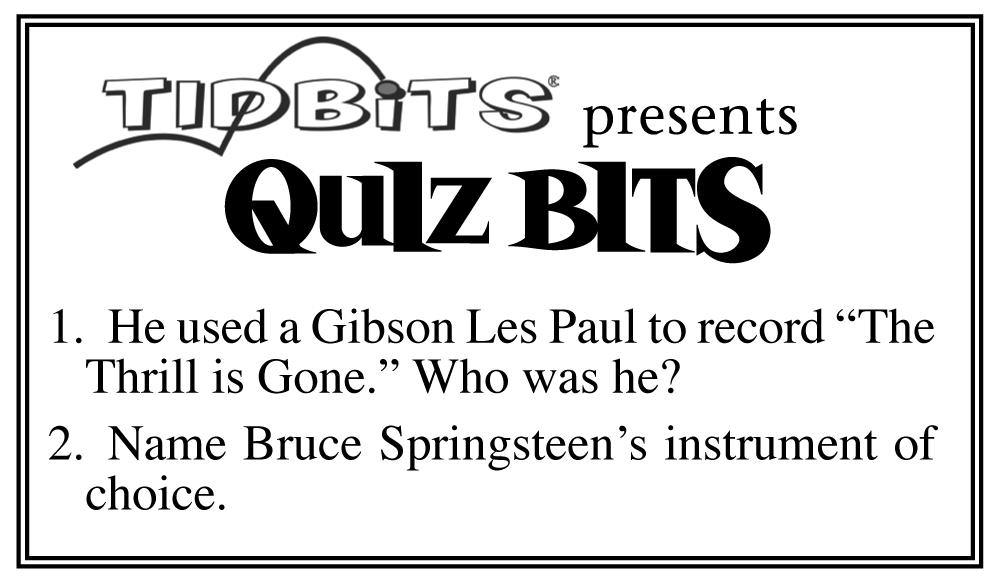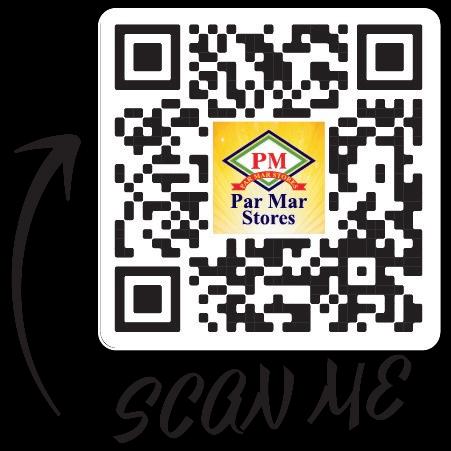








by Kathy Wolfe
It’s not the most popular instrument in the world – that honor belongs to the piano – but the guitar comes in solidly in second place. April is National Guitar Month, and this week, Tidbits focuses its attention on the guitar and the music it brings to our lives.
• Many historians believe that our English word “guitar” has its origins in the Spanish word “guitarra,” thought to have been adjusted from the ancient Greek word “kithara,” usuallytranslated into English as “harp.”
• The tomb of ancient Egyptian Queen Hatshepsut, first discovered in 1917, contained what historians believe is the oldest recorded guitar-like instrument. The three-stringed instrument was found buried next to a performer of the royal court of the queen, who reigned from 1473 to 1458 B.C.









• G.D. Beauchamp and Adolph Rickenbacker are credited with the invention of the first electrically amplified guitar to be massproduced and marketed commercially. They called the instrument the “frying pan” because its long neck and circular body resembled that cooking gadget. Its official name was the Rickenbacker A-22, a sixstringed solid-bodied instrument made entirely of aluminum. The frying pan featured wound pickups, devices that convert the vibrations of metal guitar strings into electrical signals by creating a magnetic field. Signals are then sent to an amplifier.




























Of The Mid-Ohio Valley is Published & Distributed Weekly By: CindAl Publishing Company 812 55th St. Vienna, WV 26105
e-mail: alan@tidbitsmov.com
Advertising: 304.210.3812
We reserve the absolute right to accept, reject, discontinue or refuse any advertisement personal or commercial that we deem may not be conducive for our publication or Tidbits®. The publisher does not assume any responsibility for the claims of its advertisers. Tidbits® is committed to remain a family oriented publication. www.tidbitsmov.com
• Beauchamp and Rickenbacker invented the frying pan in 1931 and began selling it in 1932, but the patent was not awarded until 1937.
• The first Fender guitar was built in 1949. Leo Fender, the company founder, started out playing piano and saxophone in his youth. He strayed away from those around age 14, shifting his interest to electronics after studying a radio his uncle had built from spare parts. Shortly afterward, Fender opened up a small radio repair shop in his parents’ home. In his late 20s, Fender borrowed $600 (about $13,000 in today’s dollars) to establish Fender Radio Service, which included building and repairing public address systems and amplifiers for stringed instruments. Leo Fender began selling his electric guitar, dubbed the Esquire, in 1950, with its bolt-on neck, thin solid body, and single pickup. The following year brought a double-pickup guitar Fender called the Broadcaster. That name didn’t stick for long when Fender had a trademark conflict with another manufacturer, Gretsch, who already had a Broadkaster. This led to a new name for Fender – the Telecaster. That year also marked the introduction of the Fender Precision Bass, capable of producing rich low-end sounds, an alternative to the bulky acoustic double bass that couldn’t match the volume of electric guitars.
• The ingenious electric guitar inventor Leo Fender didn’t even know how to play or even tune a guitar. He hired musicians to come in and test the prototypes of all of his designs. In 1953, Fender, assisted by a draftsman, began designing what would come to be known as the Stratocaster, the first Fender to boast three pickups and a contoured body shape. The company’s head of marketing was very interested in aviation and suggested the name Stratocaster, stating that guitarists would feel like they had been “put into the stratosphere.”


When you find him, please send us a message with your name, POSTAL MAIL address, the issue number you are referring to and which ad is hosting Tommy for the week! Visit www.tidbitsmov.com or send the answer with the above information to alan@tidbitsmov.com OR you may send us a private message to our Facebook page - @Tidbits MOV. PLEASE do not post the answer directly to the page - that ruins the fun for everyone. All winners will be drawn randomly from correct responses and will be posted weekly. As with all our contests, you are welcome to play every week, you are only eligible for one winner per household per month.
















• Both the Telecaster and Stratocaster have been in continuous production since their introduction.
• Noted jazz, country, and blues guitarist Les Paul first approached the Gibson Guitar Corporation in 1941 with his innovative idea for a solid-body electric guitar he called “The Log,” because of the solid chunk of pine that ran through the body. Gibson wasn’t interested. That is, until 1950 when Fender introduced the Esquire and Broadcaster, and Gibson decided it was time to jump on the bandwagon. Les Paul had drawings of his idea and Gibson’s Ted McCarty became the chief designer of what became the Gibson Les Paul introduced in 1952. Les Paul was brought in as a consultant and spokesman in exchange for royalties on sales. The guitar made its debut played by Les Paul himself at New York City’s Paramount Theater.
• The first Gibson Les Paul had a mahogany body and neck and a rosewood fretboard. It had an opaque gold finish leading to the name “Les Paul Goldtop.” It sold for $210, which might seem affordable now, but in 1952 it was equivalent to about a month’s salary.
• Sales of the Les Paul were a little disappointing, and Gibson halted production in 1961. In its place, they introduced the Les Paul SG with a double-cutaway shape. Les Paul himself didn’t care for the shape with its two pointed horns, and wasn’t too thrilled with the use of his name on the “new and improved” model. In 1968, Gibson restarted the production of the older version, and its manufacture has continued non-stop since then.
• Universal Pictures made a boo-boo when they featured actor Michael J. Fox as Marty McFly playing a Gibson ES-345 during his time travel to 1955 in the film “Back to the Future.” That Gibson model wasn’t introduced until 1959!













• Jimmy Page used a 1960 Gibson Les Paul Custom for recording Led Zeppelin’s first album, a guitar he had bought on layaway in London when he was 18. In 1970, this “Black Beauty” was stolen from the Minneapolis-St. Paul Airport, and remained missing for 45 years until it was discovered in a Twin Cities music store, recognized by the guitar repairman, who returned it to Page. Things didn’t end as happily for Eric Clapton, whose 1960 Les Paul Beano was used for recording the 1966 album “Bluesbreakers.” Clapton’s guitar was stolen from a church hall practice room shortly afterward and hasn’t been seen since.
• The most expensive guitar ever sold to date is a Martin 1959 D-18 acoustic. This instrument sold for $6 million at a June, 2020 auction. Why the astronomical price tag? It had been owned by Nirvana’s frontman Kurt Cobain.
• A tribute to guitarist Jimi Hendrix set the record for the most people to simultaneously play guitar. The “Thanks Jimi” Festival is held every year in Wroclaw, Poland, and in 2019, 7,423 guitarists joined together to play Hendrix’s hit “Hey Joe.” The event was first held in 2003 with 588 guitarists showing up in the community’s market square. Hendrix, a Seattle native, died in 1970 at age 27.
• In 2011, Irishman Dave Browne set out to set a record for the longest time playing a guitar non-stop. He accomplished the challenge at Dublin’s famous Temple Bar pub, where he played for 114 hours, 20 minutes. Browne was allowed a 30-second break between songs and a 40-minute break every 8 hours. During his gig, he played 1,372 different pieces of music, with a requirement of at least two minutes each, about 12 songs every hour. For a few hours, Browne was privileged to play a rare signed limited edition Stevie Ray Vaughan Fender Stratocaster, loaned by a patron. It was the first time the guitar had been played in 20 years.






Arroz con Pollo: The One-Pot
Your Family
(and Your Wallet!)
Arroz con Pollo translates to "Rice with Chicken" in Spanish, but it's so much more than that. This dish shows up in almost every culture because it's cheap, easy to make, feeds a crowd and everyone loves it.
The magic happens when the chicken, rice and veggies simmer together, creating a one-pot wonder of juicy chicken, flavorful rice and vibrant peppers and tomatoes. This is my go-to recipe when chicken thighs go on sale. And if you're lucky enough to have leftovers, they're even better the next day. It freezes beautifully, too.
The beauty of Arroz con Pollo is its flexibility. While I swear by bone-in, skin-on chicken thighs for maximum flavor, feel free to swap in any chicken pieces you like legs, breasts or a combo. Bone-in, skin-on chicken does bring a deeper flavor, but boneless and skinless will work if you're watching your waistline or just need to make things quicker. Want a little heat? Toss in some serrano or jalapeno peppers with your onions and bell peppers.

harm if you leave them out, though. It's still delicious either way!
Yield: 4-6 servings
Total Time: 50 minutes
2 teaspoons salt
1/4 teaspoon black pepper
1 teaspoon garlic powder
1 teaspoon dried cumin
3-4 pounds chicken thighs, bone-in, skinon
3 tablespoons olive oil
1 (16 ounce) bag frozen onion and pepper blend, thawed
1 1/2 cups long-grain white rice
2 cloves garlic, finely minced
1 (14.5 ounce) can chicken broth
1 (8 ounce) can tomato sauce
1 (14.5 ounce) can diced tomatoes with chilies
1 cup frozen peas, thawed (optional) 1/2 cup manzanilla pimiento-stuffed green olives, chopped (optional)
In a small bowl, combine the salt, pepper, garlic and cumin. Pat the chicken thighs dry with paper towels and sprinkle the seasonings evenly over them.
Heat olive oil in a large skillet over medium-high heat. Cooking in batches if necessary so you don't crowd the pan, add the chicken, skin side down, into the skillet. Brown chicken on both sides, about 5 minutes per side. Set aside.




Arroz con Pollo: A comforting one-pot meal that's as budget-friendly as it is delicious. PHOTO CREDIT: www.JasonCoblentz.com Mon-Sat
You can use any rice you've got on hand but, just be aware that the cooking time and liquid amounts may vary. And if you're a brown rice fan (like me), go ahead and use 3 cups of pre-cooked brown rice when you add the tomatoes. Just skip the broth and water for this one- because, let's face it, brown rice rules. Oh, and peas and green olives? Totally optional, but I love how the sweet peas and salty olives balance out the dish. No
Reduce heat to medium. In the same skillet, saute onion and pepper blend until softened. Add salt, rice and garlic; saute until rice is golden and garlic fragrant. Add chicken broth, tomato sauce, diced tomatoes and 1 cup water. (I rinse out the tomato cans with the cup of water and add it to the pot. It finally happened; I have become my mother.) Stir well. Return chicken to skillet, skin side up, nestling pieces in rice mixture. Ensure rice is covered with liquid. Cover and sim-



mer on low for 30-35 minutes until rice is tender and chicken reaches 165 F. Add the peas and/or olives and stir. Serve hot. This one-pot meal stands on its own, but a crisp salad and/or green beans with almonds would make great sides. Next time chicken thighs are on sale, give this frugal family favorite a try it's like a culinary hug from your abuelita! ***
Lifestyle expert Patti Diamond is the penny-pinching, party-planning, recipe developer and content creator of the website Divas On A Dime Where Frugal, Meets Fabulous! Visit Patti at www.divasonadime.com and join the conversation on Facebook at DivasOnADimeDotCom. Email Patti at divapatti@divasonadime.com
(c) 2025 King Features Synd., Inc.















They’re low maintenance, that’s for sure! This week, Tidbits examines this craze of the 1970s that made one man a millionaire in just a few months.


• It was guys’ night out in April, 1975, and freelance advertising copywriter Gary Dahl was out with friends, listening to them complain about the work involved in caring for a pet. Gary was the odd man out – he didn’t have a pet. To join in the discussion Gary told them his pet was no trouble because his pet was a rock. Everyone laughed at his joke, but after Dahl gave it some thought, it was no longer a joke.
• Figuring that no one would buy a plain old rock, Gary settled on smooth rocks from Rosarito Beach in Baja California, Mexico. Each rock cost him a penny.
• The packaging was next and he designed a custom cardboard box with ventilation holes and straw bedding mimicking a pet carrier, with lettering on the side announcing, “This box contains one genuine pedigreed pet rock.”
• Dahl then set to work on a 34-page owner’s manual, “The Care and Training of Your Pet Rock.” It included instructions for teaching the rock to stay, sit, and play dead, and touted the rocks “long life span” as a faithful companion. They would not need to be fed, walked, bathed, or groomed, and would never become sick or be disobedient.
• Gary Dahl debuted his creation at a San Francisco gift show in August of 1975, and within two months was selling 10,000 a day at $3.95. Using his advertising experience, he launched a giant campaign, featuring himself surrounded by the Pet Rocks. After expenses for packaging, he was making about a dollar a rock. He added Pet Rock T-shirts and shampoo to his line to capitalize on the upcoming holiday season. (Continued page #7)
































• Neiman-Marcus ordered 1,000 packages, and Bloomingdale’s also carried the rocks. Dahl became somewhat of a celebrity, appearing on “The Tonight Show” twice, giving multiple television interviews, and being written up in “Newsweek” magazine. Over the 1975 holiday season, Dahl estimated he was selling nearly 100,000 Pet rocks a day.
• Although Dahl obtained a trademark for the name “Pet Rock,” he really couldn’t patent a rock, which enabled other companies to sell their own version.
• In February, 1976, the Pet Rocks had hit their peak and were being discounted due to lower sales, but what did it matter to Gary Dahl? What had started out as a joke in a bar resulted in sales of nearly 1.5 million rocks, making Dahl a millionaire in a matter of months. He wasn’t concerned about all the rocks that didn’t sell, saying he would use them to repave his driveway.
• Dahl used his profits to purchase a bar in Los Gatos, California, as well as embarking on other marketing ventures. He tried another fad selling “Sand Breeding Kits” and “Red China Dirt,” but they didn’t attract much interest. Dahl produced thousands of television and radio commercials through Gary Dahl Creative Services, and in 2000 won the Bulwer-Lytton Fiction Contest. In 2001, Dahl published “Advertising for Dummies, “a business guide for producing effective ads, reaching the target audience, evaluating the competition, and other marketing strategies.
• Gary Dahl passed away in 2015 at age 78.










Is this puppy ready for a long hike?
DEAR PAW'S COR-
NER: I adopted a beautiful pup at about 3 months old this winter. Now that the weather is warming up and "Blondie" is about 6 months old, I can't wait to start going on hikes with her. How far can a puppy that age walk? Do you have any safety tips? Carl J., via email
DEAR CARL: Blondie sounds like an amazing pup! With the correct training, she will eventually be able to accompany you on some hikes but not this season.
Puppies at 6 months of age should only take limited walks, ranging from five to 10 minutes max, on level ground. Don't take them farther pushing them too soon can cause a host of physical problems because their growth plates haven't fused.
Most experts recommend lengthening walks gradually starting from about 9 months. For longer distances over uneven ground, and when training dogs to carry their own panniers, wait until they are 12 to 18 months old.
So, you won't be able to take Blondie with you on day hikes this year unless you carry her. There are special "sport sacks" just for carrying small- to medium-size dogs. Think of it as a fitness challenge for you, and a way for your pup to learn to love the outdoors.
In the meantime, you can work on Blondie's obedience training. It's critical that she respond immediately when you call her, especially out on hikes. She should also be well socialized to people and other dogs this prevents a lot of grief on the trail. Right now is the perfect time to do that, and to bond with your dog so that you have fun whether you're outdoors or not
Send your tips, comments or questions to ask@pawscorner.com.






* Spring planting supplies are on sale now in homeimprovement stores, and here is a handy and fun twine keeper that you can make with your kids using two repurposed clay flowerpots with drain holes. Choose a size that can easily fit a ball of twine or thin rope. Set the ball inside and invert one pot on top of the other, threading the line through the drain hole of the top pot. Secure with tape or even hot glue. Pull twine through the hole, and the ball doesn't get tangled up.

* "After too many mornings of rushing to find uniform pieces before a game, we decided to get smart. Now, sports uniforms get hung up with all accessories in the coat closet right after washing. They're ready as soon as it's game night no looking under beds or in the back of overstuffed teenager closets!" P.P. in Texas


* "If you have a poster that has been rolled up and you want to hang it up, try rolling it the opposite way overnight. When you unroll it, there will be less bumps and the edges won't curl so bad." R.L. in Idaho
* The best way to cool canned and bottled drinks down fast is in a mix of ice and water. The water is a better conductor of the cool. Then make your ice last longer and stay colder by sprinkling a little salt on the ice/water mixture.

* "To hold all my daughter's bobby pins, I mounted a plastic cup with double-stick tape right to her vanity mirror. I used to vacuum them up all the time, but now that she has a place to put them, it's better." L.E. in New Hampshire
Send your tips to Now Here's a Tip, 628 Virginia Drive, Orlando, FL 32803.
(c) 2025 King Features Synd., Inc.




